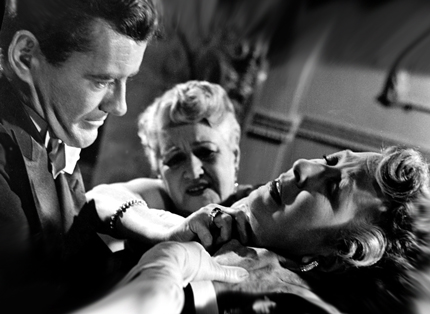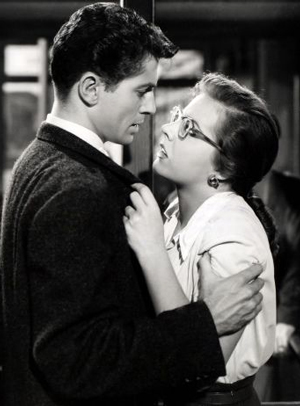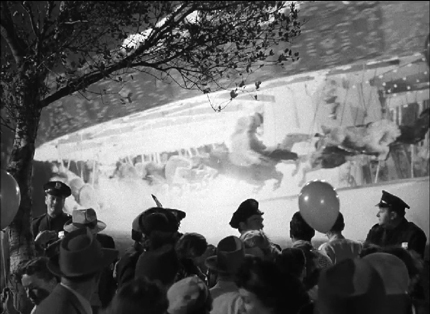
 |
|
|
|
Alfred Hitchcock's Strangers on a Train was claimed by Robin Wood as the director's first 'mature' masterpiece, critically speaking. Hitchcock has woven the story's main themes deeply into the visual presentation, down to the level of individual shots. Unlike his previous films, that were beginning to rely on visual and narrative gimmicks, this one is a crooked noir tale often told completely with the camera. The overwhelming visual inventiveness places us at the center of Hitchcock and author Patricia Highsmith's twisted moral tale. Critics have made arguments for the presence of coded homosexual undertones in many older pictures, but in this case it's undeniable -- the story is about a bizarre illicit pact between two very ambiguous men. Patricia Highsmith also wrote The Talented Mr. Ripley, another story about the interchangeability of identities. Famous hardboiled author Raymond Chandler takes a screenwriting credit on the film. Hitchcock literally brings his characters together on converging paths of fate. Tennis pro Guy Haines (Farley Granger) would like to parlay his celebrity into a political career. He is on his way to ask his unfaithful wife Miriam (Laura Elliott, aka Kasey Rogers) for a divorce, when he meets eccentric Bruno Anthony (Robert Walker) on the commuter train. Among other wild ideas, Bruno proposes that the two men swap murders, as Bruno has an inconvenient father back home that needs to be disposed of. Guy laughs off the bargain, only to be shocked when Bruno carries out his half of the commitment by strangling Miriam at a funfair. Now the madman expects Guy to reciprocate. Bruno has Guy over the ropes -- if he won't follow through, Bruno has the motive and the evidence to nail him for Miriam's murder. 
Still one of Hitchcock's most tightly plotted thrillers, Strangers on a Train is like a textbook on how to "read" a film on a visual-literary level. The master's favorite theme, the transference of guilt, is explicit in the sordid relationship between Guy Haines and Bruno Anthony. The movie's nominal romance seems almost irrelevant. Ruth Roman is at her coldest here as Guy's secret lover Ann Morton. Ann seems less concerned about the murder than she's afraid of what will happen if Guy is implicated: "It could separate us." Even Nancy Drew would set out immediately to clear her boyfriend's good name, but Anne Morton prudently waits in her comfortable house for Guy's situation to resolve itself. Although she surely delivered exactly the performance Hitchcock wanted, I still prefer Ruth Roman's sexy vulnerability in The Window to her waxwork presence here. The real fireworks are between Guy and Anthony. Anthony initially comes off as an entertaining nut. Guy is sufficiently shallow to be entertained by Anthony's grandiose personality, and sours only when the subject of his despised wife is mentioned. Guy openly expresses his wish to personally strangle Miriam, and Anthony follows through for him with cool precision. It's less a criminal pact, than a bonding ritual between men. "See," Anthony seems to be telling Guy, "I'm dependable, loyal, and your true best friend." Even Shakespeare agrees that murder can be a dramatic way of proving one's love. Bruno Anthony is one of those movie characters that are gay in every way except explicit mention. Robert Walker uses a number of stock mannerisms, from Bruno's swooning speech affectations to the way he minces when he walks to take a long distance phone call. Yet Bruno's undeveloped sexual orientation is only one facet of a uniquely dangerous villain. He has a pathological relationship with his parents, is militantly determined to be socially unproductive (sure villain material in 1951) and is completely sincere in his affection for Guy. Indeed, he's both patient and solicitous of his new 'partner's' unaccountable lack of cooperation. A sociopath incapable of seeing anyone else's point of view, Bruno is the extreme example of the interpersonal crime known as, "You're not keeping YOUR part of MY bargain!" 1 This is Hitchcock's first "power suspense story," where the dynamism is driven not by lavish action scenes or intense romantic melodrama, but by Hitchcock's nuts 'n' bolts cinematic engineering. Airplanes don't crash and there are no giant noses of Ingrid Bergman and Gregory Peck colliding. Instead, our attention is riveted by things as simple as two pairs of walking feet compared in a parallel cutting structure, capped by intersecting rails that visually represent the inevitability of the collision between Guy and Bruno. Plenty of Hitchcock movies move from set piece to set piece in whatever expedient way can connect them, but in Strangers on a Train the set pieces are organically structured and feed off one another. The penultimate suspense scene crosscuts a punishing tennis match with Bruno's herculean effort to retrieve a cigarette lighter from a storm drain. Neither action by itself represents a really successful suspense sequence, but together they're breathtaking, especially when amplified by Dimitri Tiomkin's dynamic score. Hitchcock flexes his ability to spin visuals in uniquely creative directions. Bruno seems to emerge from Guy's nightmares (or his inner sexual confusion) and as such is frequently portrayed in terms derived from the dream visions of Spellbound. Bruno stalks Guy, appearing against public monuments in disturbingly static poses, like the "man with the wheel" in the Dali dream. When he hides behind an iron gate across from Guy's apartment, Bruno becomes Guy's unacknowledged but "always there" secret identity, his Secret Sharer. As Robin Wood pointed out, the most meaningful visual moment in the film is when Guy crosses from one side of a gate to the other, guiltily joining Bruno in hiding from the law. 
Finally, the odd "island of love" at the carnival is Alfred Hitchcock's biggest thematic joke. It might as well be the Island of Heterosexual Lust, which the film consistently identifies as sordid and disgusting. Miriam's cheap flirting and open sensuality was clearly meant to be reprehensible in 1951. She trades light sex jokes with her two escorts, both of whom will expect sexual favors, we imagine. The trip to the island is made on boats with mythical names through a tunnel of love with its pawing and tickling. Bruno's good ship PLUTO points to a trip to Hell. Finally comes the island (are the boats on tracks or independent, or what?) that seems nothing less than an acre set aside for sex. To commit his perfect crime, Bruno has penetrated into the heart of darkness of enemy territory, in terms of female-male relations. And as if inaugurating the Giallo genre, a sexually flirtatious female is open season for a murderer. As far as guilt goes, Guy Haines' guilt is thematically equal to that of Montgomery Clift's character in A Place in the Sun. Guy wants Miriam dead, and Bruno carries out his unconscious/conscious wish as efficiently as Morbius' Id Monster from Forbidden Planet. Guy's hoped-for political future is a destiny usually associated with opportunism. Neither it nor his tennis career could stand a serious scandal, and Bruno conveniently paves the way for a "decent" relationship with Anne Morton and her all-important Senator father. Unlike A Place in the Sun, Hitchcock's hero disposes of his inconvenient past and gets a free roll of the dice in the Great American Success Game. Seen again, Strangers on a Train lets us admire its powerful music and impressive cinematography. Tiomkin's blaring score doesn't overwhelm the visuals as happened in D.O.A, and in Robert Burks Hitchcock found a cameraman who could give him the visual precision he needed. Shots are not only unusually sharp, but Burks masterfully expresses the passage of time from afternoon to night in the scenes at the fair. Hitchcock would continue to use Burks for many of his '50s masterpieces. Hitchcock knows his audience is a guilty bunch that secretly comes to his movies to see adultery, murder and mayhem. He often acknowledges our desire to let chaos reign. The Birds is his poetic version of On the Beach, where doom seems to come from inconsequential tensions between his characters. Some of his earlier films tease us with outrageous, almost-realized calamities. He found out the hard way that doing things like killing children (in Sabotage) can make audiences resentful. They want to be taken to the brink and then let off the hook, as when Cary Grant drives a Mercedes half-off a cliff, drunkenly acknowledges his mistake, and then accelerates back onto the highway. The carousel calamity at the end of Strangers on a Train is an extreme example. Hitchcock can't resist making the chaotic fairground with its secret pleasures and island of sex explode into a disaster scene. The carousel is packed with teens and children, and Guy and Bruno's selfish squabble triggers what looks like a lot of indiscriminate killing. It's the perfect Hitchcock action finale because (a) The mayhem is thrilling (b) It's patently absurd. An exponentially accelerating carousel? They're barely powered enough to turn. Also, (c) It's FUN. Bodies flail out with the centrifugal (or is it centripital?) force. The wooden carousel horses become harpies, silently screaming of impending doom. 
Once again, Hitchcock gets away with murder. In a beautiful extended miniature shot the finale shows the carousel smashing itself to flinders. The rush to recover the maimed and dead is ignored in favor of resolving Guy's little guilt problem. Hey, there are little kids under that wreckage, and we're supposed to be worried about Guy Haines' political future? That's an extreme judgment but the fact remains that Hitchcock played with disaster as a way of shaking up his complacent, thrill-hungry audience. With the present constant diet of war and terrorist mayhem around the world and right here at home, the macabre slaughter at the end of Strangers on a Train is now perhaps less thrilling and a little more disturbing, even traumatic. Warner's Blu-ray of Strangers on a Train replicates the presentation of the 2004 special edition DVD. Robert Burks' razor-sharp B&W cinematography comes across in all its beauty in the HD transfer, revealing detail and nuances not seen before. Bruno's visit to the fun fair begins with a wait at a bus stop that seems a throwback to the secure small town atmosphere of Shadow of a Doubt. Hitchcock's insistence on the carnival as crude and sinful now seems unfair to carnivals. The most notable extra is still the second version of the movie discovered a couple of decades ago in the Warners' vault. Once identified as an English version, it is actually a preview cut. It differs enough to intrigue the cultists but mainly has only two or three diverging bits, with editorial adjustments made all the way through. It is as beautifully mastered as the release version. The longish docu with the dull title A Hitchcock Classic covers all the usual bases and a few more, doing a good job with a film that was fully analyzed a generation before. (Does that mean that a new interpretation is overdue?) A full commentary edits together the observations of many speakers. Peter Bogdanovich delivers the film school basics. Pat Hitchcock and Robert Walker Jr. are welcome participants; the film certainly represents her best movie role. Critic Richard Schickel's remarks are lax and informal, but he gets in a number of good observations. I liked Kasey Rogers' account of working on the movie (as Laura Elliott). Her description of the filming of the famous murder reflected in the glasses is excellent. Ms. Rogers was a Paramount contract player loaned for this one film. She did a super job as the difficult-to-play character Miriam and then was totally ignored by the press. Paramount didn't want to publicize a Warners' picture and Warners didn't want to publicize an actress with a Paramount contract. That seems totally unjust. Other items are some Hitchcock family home movies, narrated by Pat Hitchcock, the original trailer, and some outtake newsreel shots of Hitchcock being big farewell on a train by people in costume. It's not clear what's going on. An 'appreciation' featurette by director M. Night Shyamalan doesn't fare so well as his observations are shallow at best. Getting today's directors to comment on the older pantheon types is a risky proposition, especially when so few of the new practitioners can hold a candle to the greats. Brian DePalma at least knows what's really good about Hitchcock. Shyamalan hasn't a clue.
On a scale of Excellent, Good, Fair, and Poor,
Strangers on a Train Blu-ray rates:
Footnote:
1. Quoted from the brilliant text of the musical How to Succeed in Business Without Really Trying. In my experience, that complaint is the #1 factor behind most spiteful personal disputes.
Reviews on the Savant main site have additional credits information and are often updated and annotated with reader input and graphics. Also, don't forget the 2011 Savant Wish List. T'was Ever Thus.
Review Staff | About DVD Talk | Newsletter Subscribe | Join DVD Talk Forum |
| ||||||||||||||||||